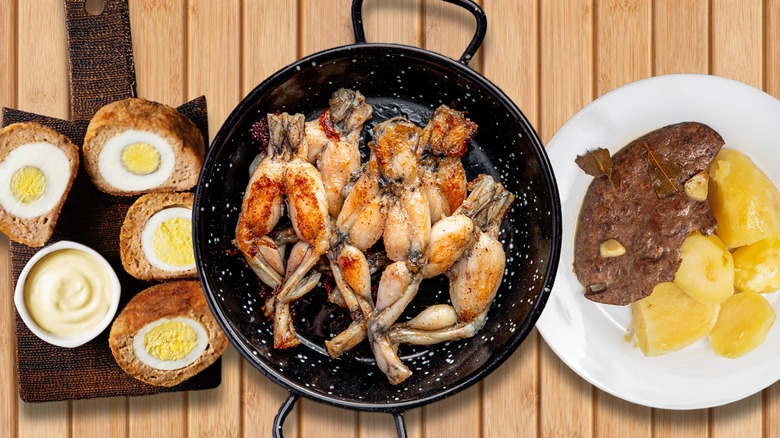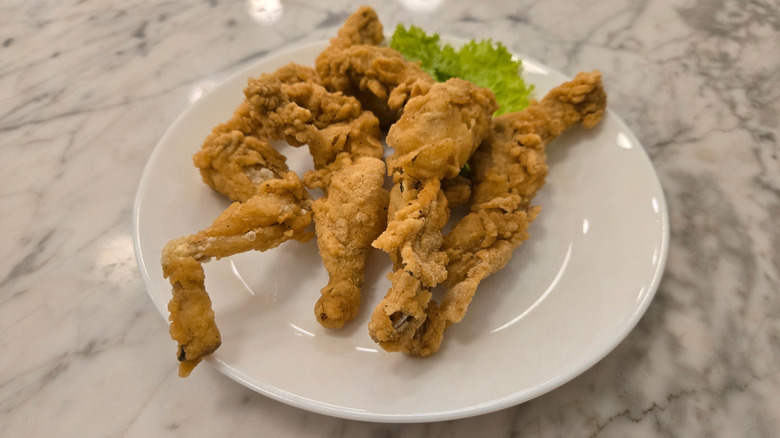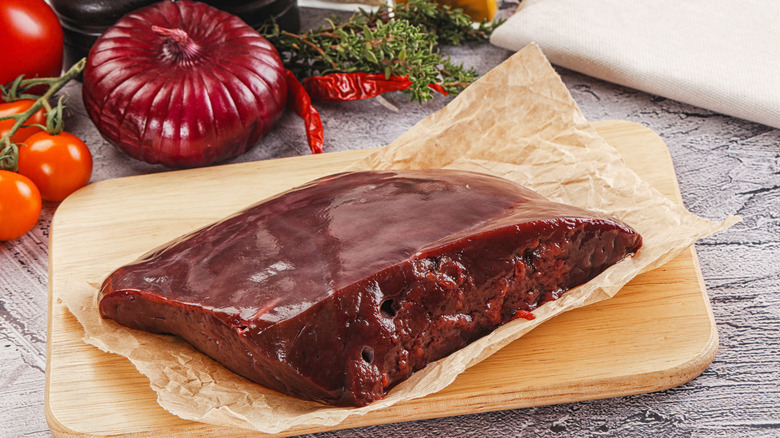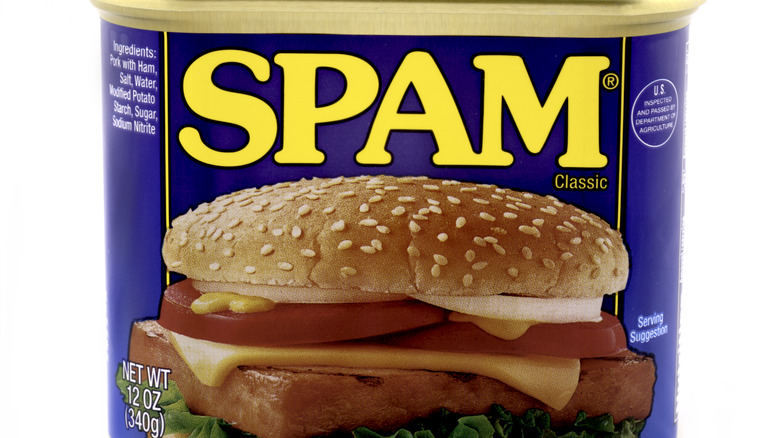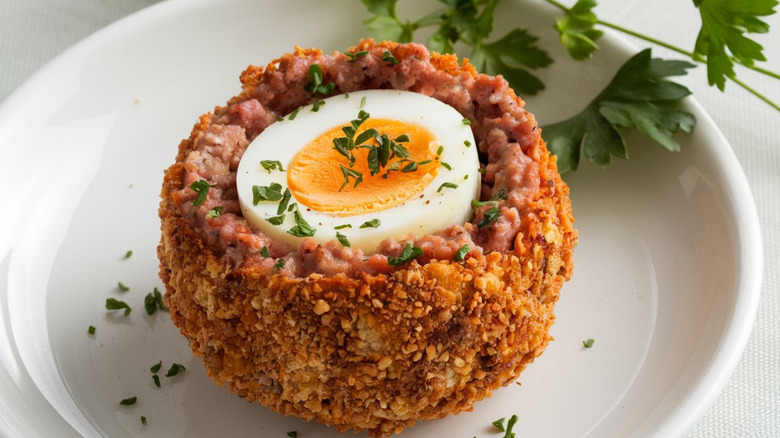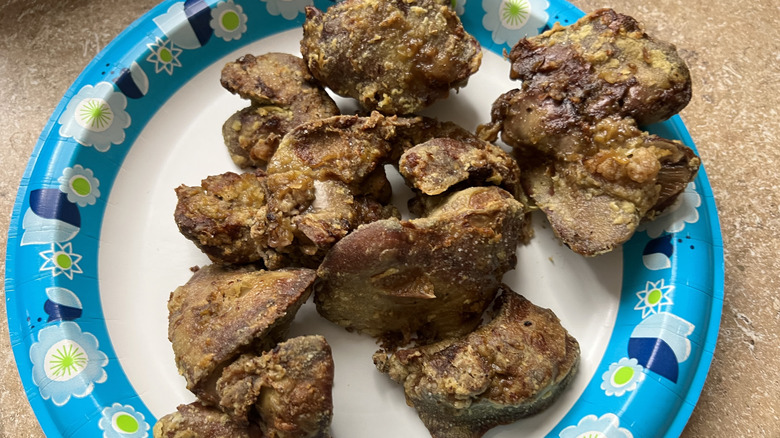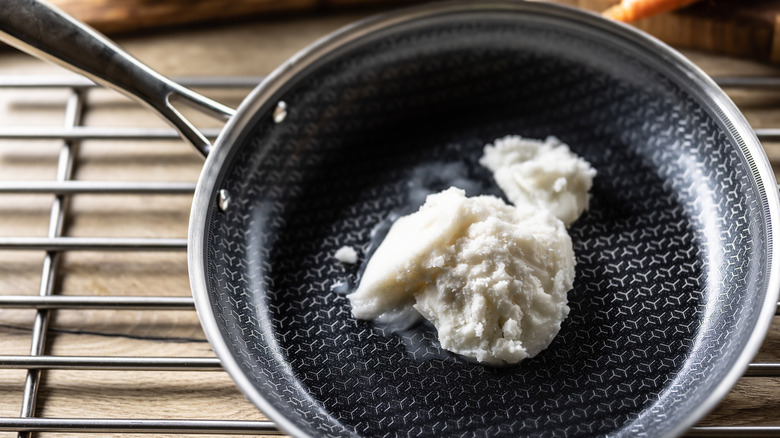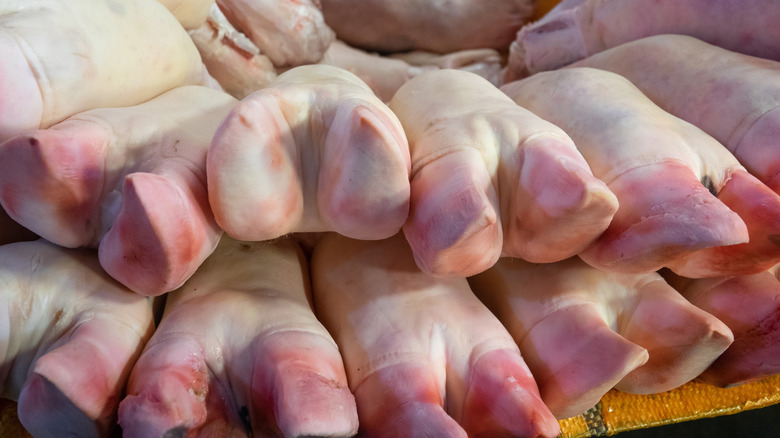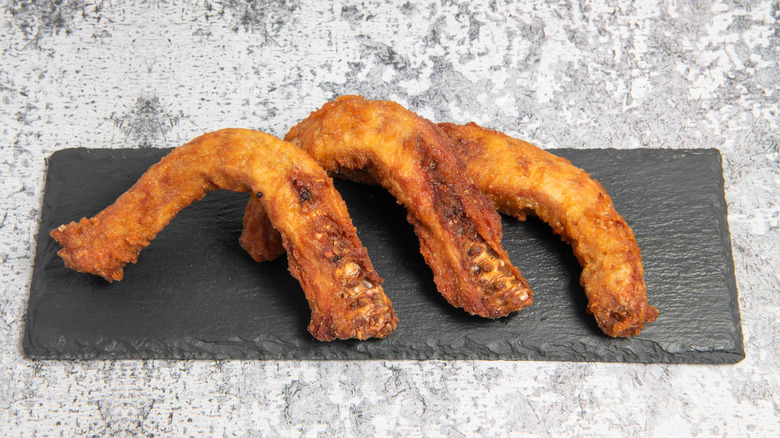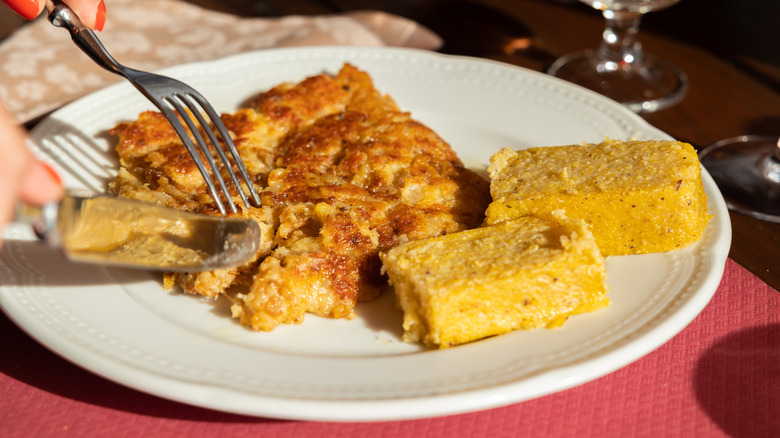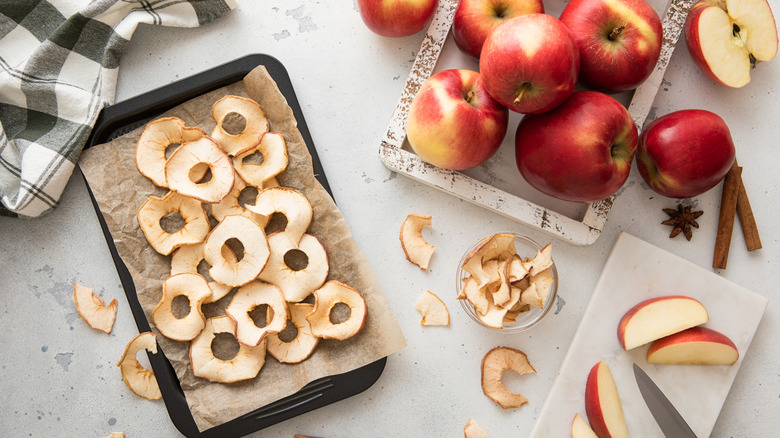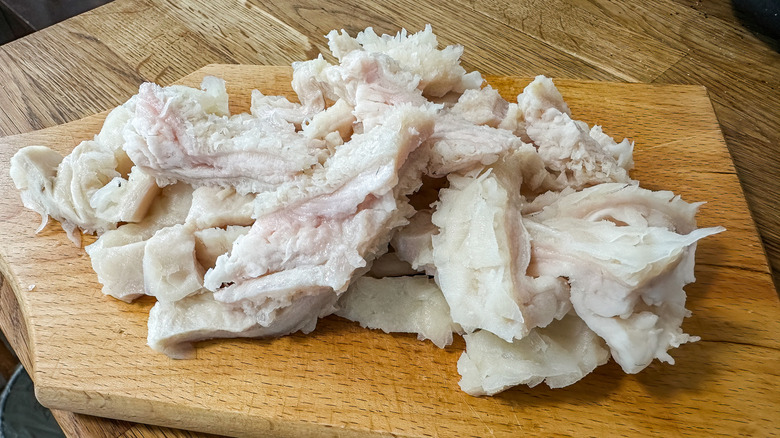Vintage Fried Foods Hardly Anyone Eats Anymore
Culinary trends come and go for a variety of reasons, and fried food is no exception. You can find examples of deep-fried food back in Ancient Rome, where dough was submerged in hot oil to create various treats. In the 16th century, the Japanese discovered deep-frying techniques from trade relations with the Portuguese, resulting in the flaky tempura we know and love today.
In the U.S., vintage foods tell stories of resourcefulness as well as regional pride and changing tastes. Throughout much of the 20th century, people fried what they had on hand, turning pork brains, chicken livers, and pig feet into crunchy delicacies. Though plenty of Americans find offal awful nowadays, these foods can hold a lot of nostalgia, especially when they've been passed down through the generations. While you probably won't find some of these old-fashioned fried foods on restaurant menus or kitchen tables anymore, they linger as culinary curiosities, evoking memories of cast iron pans and electric skillets sizzling with oil.
Fried frog legs
While platters of fried frog legs may conjure visions of vintage bistros serving rustic countryside fare in France, the dish is likely much older than French cuisine. According to National Geographic, archaeologists in England found evidence of humans consuming frogs as far back as 10,000 years ago. Beyond the prehistoric and French diets, frog legs are also popular across Asia. No matter the country or time period, though, frog legs have been enjoyed deep fried, grilled, or sauteed with butter, lemon juice, and seasonings.
In the U.S., frog legs are almost exclusively eaten in the South, where they're traditionally prepared in a deep fryer or skillet with hot, bubbling oil. Although somewhat contentious, hunting for frogs –– or frog gigging –– is still practiced across some Southern states. Hunters row out into ponds late at night and use flashlights to blind frogs near the water's surface. Then, they use long poles with sharp ends to spear the amphibians. Typically, only the frogs' legs are eaten, often coated in a batter of buttermilk and seasonings, then deep fried until golden brown.
Fried beef liver
Beef liver is one of those polarizing food items you either love or hate, with no room for hanging out in between. Pan-fried liver has been a staple mealtime dish across generations in the U.S., often served with sauteed onions and a variety of hearty sides. Although the organ meat has been enjoyed for centuries, it rose in popularity during the Great Depression and World War II. Beef liver is also revered for its high nutritional value, delivering plenty of protein and iron.
Fried beef liver has been especially widespread in areas that enjoy beef and also prioritize using every part of the animal. Think, for example, of the rural Midwest. Because offal is typically a cheaper cut, it's a dish that's often rooted in necessity. Many recipes call for dredging bite-sized pieces of the organ meat in seasoned flour and frying them in oil or butter. Although modern tastes have changed, the dish still evokes a time when resourcefulness met flavor in a cast iron skillet. Although you'd be hard-pressed to find it on a restaurant menu, you can still try a classic fried liver and onions at home.
Fried Spam fritters
One of the many Spam myths we need to debunk is that the canned meat product was invented during World War II. While fried Spam fritters became popular during World War II, the product itself was actually invented in America in 1937. When fresh fish became unavailable due to wartime rationing in England, fried Spam fritters were born out of necessity. Slices of Spam were battered and deep fried to a golden, crunchy brown as a creative substitute for fish and chips. The dish was served with the traditional accompaniments of French fries or peas, and the convenient, shelf-stable protein was popular among both soldiers and civilians.
Even though you most likely won't find Spam fritters on eatery menus or on kitchen tables anymore, they remain an intriguing reminder of wartime resourcefulness. To bring a bit of vintage nostalgia into your kitchen, consider frying up the fritters at home. You can get creative by adding beer to the batter for an added flavor profile. The batter also ensures that the meat product stays sweet, salty, and juicy on the inside and crispy on the outside.
Scotch eggs
If you're a lover of crispy, savory breakfast foods, the old-fashioned Scotch egg may be for you. Its origins are up for debate, so you could say this creative culinary invention is wrapped in both mystery and meat. Scotch eggs –– which have a soft, creamy center and airy, deep-fried exterior –– are thought to be Scottish because of their name. One theory, however, credits London's Fortnum & Mason department store with inventing the delicacy in 1738. The dish can also be traced back to an Indian dish called kofta, which similarly consists of a boiled egg coated in spiced minced meat and fried. Others say that the Scotch egg has roots in Yorkshire and was named after a local eatery called William J. Scott & Sons.
No matter the origin story, Scotch eggs became a beloved convenience food over the years. They can be enjoyed warm or at room temperature, ideal for packing along on picnics. Although you might not find them on menus nearly as often anymore, the eggs were also a staple of the British pub scene. To make these nostalgic treats at home, you need parboiled eggs with a jammy center (the one food Keke Palmer eats every single day, by the way), breakfast sausage, and breadcrumbs.
Fried chicken livers
Chicken livers are another type of organ meat that people either see as a delicacy or look at in disgust. Lowly livers are considered humble fare with a rich history rooted in Southern tradition and cuisine. Chicken livers were a staple in rural homes, where no part of the bird went to waste. When fried correctly, chicken livers have a consistency comparable to oysters, delivering a soft, juicy interior and a light, crispy exterior. Some even feel that livers are the most delicious and most overlooked part of the chicken.
Throughout the 20th century, popular fast food chains like Holly Farms Chicken and KFC even offered fried chicken liver on their menus. By 1989, however, Holly Farms Chicken had closed. Although KFC no longer offers the offal on its regular menu, you may be able to order it at some regional locations. Today, in some parts of the U.S., particularly the South, chicken livers remain a cherished comfort food, revered for their affordability and nostalgic flavor. The meaty, iron-rich nuggets are often dredged in seasoned flour and deep fried to a crispy, golden brown. You can even douse fried chicken livers with a bit of fresh lemon juice and hot sauce for a bolder flavor.
Lard-fried chicken
Once popular at dinner tables, lard-fried chicken isn't for the faint of heart (or those with heart issues, for that matter). While frying lean meat in rich animal fat may seem counterintuitive, no one can argue about its level of deliciousness. Lard-fried chicken dates back to the kitchens of pioneers and farmers, where all parts of an animal were used during the cooking process. Before vegetable oil and commercial shortenings became more widespread, using lard, or rendered pork fat, was one of the most common methods for frying. Besides being cheap and convenient, it was used for its high smoke point and rich flavor. Early cooks knew that the fat kept chicken meat moist and juicy while making the skin light and crunchy.
It may have been Scottish immigrants who brought the technique of lard-fried poultry to the American South, where it met the bold seasonings and unique frying methods of African Americans. These traditions converged to create the early versions of the fried chicken we know today. Although using animal fat has largely fallen out of popularity due to its health impacts, some cooks still believe that frying chicken in lard is the best way to prepare it. Thanks to its saturated fatty acids, lard won't break down at the high temperatures needed for frying, unlike vegetable oils.
Fried pig feet
While the thought of fried pig feet may have you running out of the kitchen, it was once a common dish, especially in the American South. The fact that this often-overlooked animal part was once a popular meal is another testament to the resilience and creativity of old-school cooks. The American versions of fried pig feet may date back to the antebellum era, when enslaved African Americans were given the least desirable parts of animals to eat. Pickling was one method used for preparing the trotters, which both preserved them and imparted a bold, savory flavor. Frying them in lard was another option.
Fried pig feet became a soul food fixture over the years, commonly served with traditional side dishes like cornbread, fried okra, and collard greens. Although crunchy fried pig feet are less common today, they remain a symbol of resourcefulness and pride. If you want to try frying pig feet in your own kitchen, it can help to simmer them in a pot of water with various seasonings first.
Fried chicken necks
Fried chicken necks may sound like an unlikely delicacy, but this humble dish was also born from a tradition of thrift. Historically, scrap cuts like chicken necks, feet, and gizzards were used to fill out and flavor broth. However, in some regions of the U.S., particularly the South, these inexpensive pieces of meat were deep fried in a hot skillet of oil, giving new life to basic cuts. During the Great Depression, fried chicken necks would have been especially popular to make the most out of the whole chicken. The dish was also a popular soul food staple, capable of withstanding Cajun spices and jerk seasoning. Nevertheless, some traditional recipes used seasonings sparingly, preferring instead to fry them in lard and let the necks' natural flavors shine.
While you aren't likely to find fried chicken necks on many modern menus, they may still pop up at regional cookouts, quaint roadside diners specializing in local cuisine, and family kitchens. To prepare this old-school dish at home, give the chicken necks a buttermilk bath, dredge them in seasoned flour, and deep fry them to crispy perfection.
Fried cornmeal mush
Fried cornmeal mush is another vintage dish rooted in rural American culinary traditions, combining simplicity with ingenuity in the kitchen. Mush, which is a thick porridge made by boiling cornmeal in water or milk, was a mealtime staple among America's pre-colonial population. Later on, cornmeal mush became especially popular wherever corn was plentiful, like in Appalachia and the Midwest. Cornfields dotted the country's prairies, providing cheap and convenient food for early settlers. Perhaps tired of eating bowls of mush day after day, pioneers would also chill it overnight and cut it into slices the next morning. When they were deep fried in oil, the mush slices were transformed into golden, crispy breakfast.
Fried cornmeal mush could be enjoyed as either a sweet or savory meal. When topped with butter and maple syrup, the fried mush became a more filling and rustic version of pancakes. Fried mush was also hearty enough to replace meat if needed. During the Great Depression, for example, fried cornmeal mush was a common and inexpensive meal. One brand that might have been found in many household pantries was Jaxon Corn Meal Mush, which was founded in 1896. Today, although it's on the list of vintage breakfast foods no one eats anymore, you can fry cornmeal mush as an alternative to polenta and serve it with crispy bacon and eggs for a nostalgic meal.
Fried apple rings
Fried apple rings are similar to beloved fritters and doughnuts, but their preparation is even simpler. This vintage dish, which was typically served as a sweet treat, can be traced back to traditional European desserts. Apples could be prepared in a myriad of ways, including baked, stewed, and fried. Like many historic recipes, frying apple rings was a creative way to prepare something that you had in abundance and might otherwise go to waste. The treat consists simply of dipping fresh apple rings into batter and deep frying them to a golden brown.
Over time, this basic recipe evolved, and now you can find the rings topped with cinnamon and sugar at some U.S. fall festivals. A seasonal favorite, fried apple rings remain a nostalgic nod to a simpler time. If you want to try making these old-fashioned treats at home, choose sweet, crunchy apples for the best results. Get creative by serving them with ice cream, dusted with crushed pecans and powdered sugar, or topped with whipped cream.
Fried tripe
Tripe is the edible lining of a cow's stomach that has long been a staple in working-class diets across Europe, Latin America, and Asia. Although it's another humble type of offal, tripe could also be prepared more intricately in refined dishes. Stewed tripe was a popular dish, but frying it made the inexpensive animal product richer and gave it a crunchier texture, most likely elevating its appeal among the masses. Frying the tripe also conceals its honeycomb appearance, which may make it less visually offensive for some. In Spain, you can find fried tripe in tapas such as callos, while it also appears as a protein-rich filling in tacos in Mexico.
You might not find fried tripe on many restaurant menus these days, so consider making it yourself if you're feeling especially resourceful and can stomach it. Since uncooked tripe can be tough and chewy, stewing it before the frying process makes it more tender. You can also add flavor by seasoning the stewing liquids. Since fried tripe has a mild flavor, you could also serve it with dipping sauces, just like how you'd enjoy chicken nuggets or French fries.
